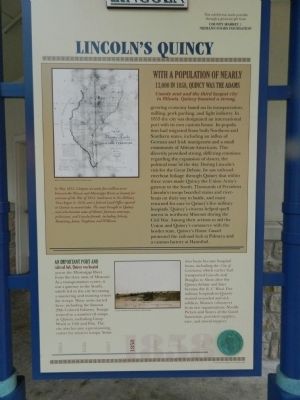Lincoln's Quincy
Looking for Lincoln
With a population of nearly 13,000 in 1858, Quincy was the Adams County seat and the third largest city in Illinois. Quincy boasted a strong, growing economy based on its transportation, milling, pork packing, and light industry. In 1853 the city was designated an international port with its own custom house. Its population had migrated from both Northern and Southern states, including an influx of German and Irish immigrants and a small community of African-Americans. This diversity provoked strong, differing emotions regarding the expansion of slavery, the political issue of the day. During Lincoln's visit for the Great Debate, he saw railroad-riverboat linkage through Quincy that within three years made Quincy the Union Army's gateway to the South. Thousands of President Lincoln's troops boarded trains and riverboats on their way to battle, and many returned for care in Quincy's five military hospitals. Quincy's citizens helped quell unrest in northeast Missouri during the Civil War. Among their actions to aid the Union and Quincy's commerce with the border state. Quincy's Home Guard protected the railroad hub at Palmyra and a cannon factory at Hannibal.
In May 1812, Congress set aside five million acres between the Illinois and Mississippi Rivers at bounty for veterans of the War of 1812. Settlement in the Military Tract began in 1816, and a federal Land Office opened in Quincy to record titles. The tract brought to Quincy men who became some of Illinois's foremost attorneys, politicians, and Lincoln friends, including Asbury, Browining, Jonas, Singleton, and Williams.
An important port and railroad hub, Quincy was located across the Mississippi River from the slave state of Missouri. As a transportation center, it was a gateway to the South, which led to the city becoming a mustering and training center for troops. many units started here, including the famous 29th Colored Infantry. Troops trained in a number of camps in Quincy, including Camp Wood at 12th and Elm. The city also became a provisioning center for western troops. Some riverboats became hospital boats, including the City of Louisiana, which earlier had transported Lincoln and Douglas to Alton after the Quincy debate and later became the R.C. Wood. Five military hospitals in Quincy treated wounded and sick soldiers. Women volunteers from two organizations, needle Pickets and Sisters of the Good Samaritan, provided supplies, care, and moral support.
Erected by State of Illinois Historic Preservation Agency & Looking for Lincoln Heritage Coalition.
Topics and series. This historical marker is listed in these topic lists: Settlements & Settlers
Location. 39° 55.98′ N, 91° 24.541′ W. Marker is in Quincy, Illinois, in Adams County. Marker is at the intersection of Hampshire Street and North 5th Street, on the right when traveling east on Hampshire Street. Marker is in Washington Park. Touch for map. Marker is at or near this postal address: 101 North 5th Street, Quincy IL 62301, United States of America. Touch for directions.
Other nearby markers. At least 8 other markers are within walking distance of this marker. Downtown Quincy in 1858 (here, next to this marker); Douglas' Disciple (here, next to this marker); Quincy's Judge Douglas (here, next to this marker); Washington Theater (within shouting distance of this marker); Lincoln Correspondent (within shouting distance of this marker); Lincoln Promoter (within shouting distance of this marker); Spread of Slavery Into The Territories (within shouting distance of this marker); Dred Scott Decision (within shouting distance of this marker). Touch for a list and map of all markers in Quincy.
Credits. This page was last revised on September 2, 2020. It was originally submitted on August 25, 2012, by Bill Pfingsten of Bel Air, Maryland. This page has been viewed 735 times since then and 13 times this year. Photo 1. submitted on August 25, 2012, by Bill Pfingsten of Bel Air, Maryland.
